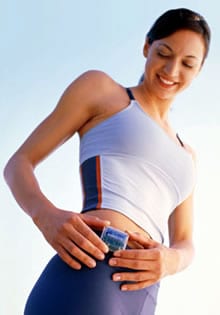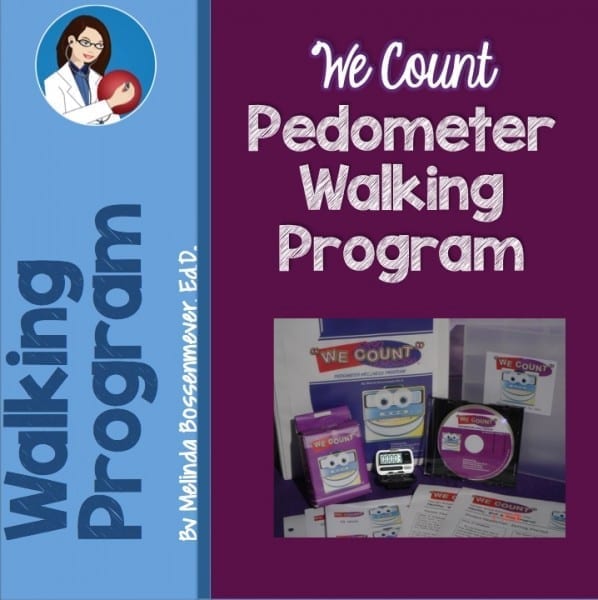You can “count on” this kids pedometer to keep track of physical activity activity.
According to the United States Surgeon General, “We have a health crisis affecting every city, state, community, and school across America. The crisis is obesity. It is the fastest growing cause of disease and death in America. However, it is completely preventable.” An inexpensive way to track physical activity is with a kids pedometer.

Experts agree that the strategy for tackling the childhood obesity is to start intervention efforts in schools.
Childhood obesity is the largest emerging health issue facing our nation. It’s serious. In fact, twenty-somethings are the first generation that are predicted to have a shorter lifespan than their parents. We need to take action. Now.
What to Look for in a Kids Pedometer.
A kids pedometer (sometimes called a step counter) senses your body motion and counts your footsteps. This count is converted into distance by knowing the length of your usual stride. Wearing a pedometer and recording your daily steps and distance is a great motivating tool. You can wear a pedometer all day, every day and record total steps. Or you can wear it just when you go out for a walking workout.
Pedometers are the tiny tool designed to measure your steps and motivate you to take more. In order to make changes in your daily exercise regimen and to stay motivated in a physical activity routine, kids pedometers can provide an awareness of activity targets and progress towards them. For instance, you may start your fitness goals with a certain a minimum number of steps per day, then increasing that goal as the weeks pass and you become more fit. Walking can help you and your family look and feel better, increase energy, sleep better and improve your mood. A 30-minute walk daily has also been shown to: help controls your weight, lower cholesterol, strengthen your heart and reduce the possibility of serious illness when you get older. The President’s Council on Physical Fitness and Sports recommends at least 30 minutes a day for 5 or more days a week. Another target to hit is 10,000 steps a day measured by a pedometer. Deciding on the correct pedometer depends on several variables. For children, a single step pedometer is generally the best. It records steps and typically distance until it is reset. Other pedometers may show calories, distances, steps, a stop watch etc. Some new pedometers that are gaining in popularity are pedometers which show steps, distance, calories, and also measure physical activity levels. For example, a more complex pedometer records time in moderate activity, or vigorous activity. This pedometer is popular for research purposes. Yet another invention over the past few years are pedometers which link with computers and allow you to record all of the above remotely as you pass a “base station” hooked to your computer. My current favorite is called “Fitbit.” It lists activity in an amount of steps taken, miles traveled, calories burned, calories consumed and activity levels such as sedentary, lightly active, fairly active, and very active. Activity time is recorded in minutes. The Fitbit also records your sleep patterns, including the time you went to sleep, the time when you awakened, and actual sleep time. Most pedometers for kids come with a clip or safety leash. It is extremely important to use these leashes/clips, since pedometers may fall off and break. In working with elementary children, I like to advise them that these are tiny little computers they are wearing on their waist band and although this is not completely accurate, kids get the picture and typically handle them with the same respect as their favorite video game. Pedometers are typically worn on a belt or on the waist band of clothes. A safety leash is a must when using with students. Walking helps kids get fit Dr. Melinda Bossenmeyer’s new We Count student walking program uses pedometers as an aid to kids in fighting fat. The We Count Walking Program is an innovative new program designed to get kids fit with the slogan, “Get Fit, Don’t Sit”… The best part of walking is its free. You can walk alone, with a pet or with friends or family. Here are some tips to assist you in being successful with a walking program. Get shoes that fit properly and are comfortable. If you want a little harder workout, it is now suggested that you jog for about 10 minutes before you start stretching in order to warm up your body. Wear loose clothes that allow you to move freely. It is typically a good idea to wear layers that allow you to peel off clothing as you get warmed up or that you can add if the weather changes during your workout. Drink plenty of water. Drink water prior to your walk, during and after. This is important for everyone but especially true for children who get over heated easily. Most people begin by a designated walk for a certain period of time, but don’t forget to take advantage of “walking opportunities” that may already be a part of your day. Can you walk to and from school or walk to work? How about selecting active chores so that you can get in some additional steps? Perhaps you can do yard work or help in cleaning the house. Or, park farther from the shops you frequent, since all those extra steps add up! Make family time to be active. Go outside for an evening walk as a family and walk around the block or play a quick game of tag or hide-and-seek. If you are walking at dusk or in the dark, be sure to wear reflective vests or bring a flash light. Stay on the sidewalk when you can and also pay attention to street signs and street lights. Research on Pedometer and particularly walking programs indicate that a good physical activity program should include 6 components: You may be wondering how many steps are enough? The charts below pin point the number of steps for active and sedentary children. The chart below is based on research by Catrine Tutor-Locke and shows a system used to classify healthy adults based on their activity level. Based on the currently available evidence, we propose the following preliminary indices be used to classify pedometer-determined physical activity in healthy adults: (i). <5000 steps/day may be used as a ‘sedentary lifestyle index’; (ii). 5000-7499 steps/day is typical of daily activity excluding sports/exercise and might be considered ‘low active’; (iii). 7500-9999 likely includes some volitional activities (and/or elevated occupational activity demands) and might be considered ‘somewhat active’; and (iv). >or=10000 steps/day indicates the point that should be used to classify individuals as ‘active’. Individuals who take >12500 steps/day are likely to be classified as ‘highly active’. Tutor-Locke Most people think of Thomas Jefferson as a politician and statesman, however, few people realize that he was an inventor as well. Jefferson invented a superb, the innovative plow. He also invented a pedometer and the collapsible folding chair, which can be used as a cane and then can be opened to provide a seat.[iv] Start walking today and don’t forget to check out pedometers. Counting steps just might be the extra motivation and feedback needed to lead you down the road to good health. We Count Student Walking Program information. 
Which Pedometer is Best for Kids?
Twenty-first Century Pedometers

How Kids Should Wear a Pedometer

New – We Count! Walking Program – Students Fight Fat
Getting Ready to Walk

Walking Safety
Research on Pedometers and Walking Programs
Goal Setting
Age Range
Gender
Step Range
8-10 years
Boys and Girls
12,000-16,000
12 years
Girls
10,479-11,274
12 years
Boys
12,300-13,989
Age Range
Gender
Step Range
8-12 years
Boys and Girls
3,500-5,500
Steps
5000
5000-7499
7500-9999
^10,000
^12,500
Sedentary
Low active
Med active
Active
Highly active
A Little History Lesson.


Related articles on Student Walking Programs
Pedometers for Kids: Tracking Physical Activity
We Count – Student Walking Program
Pedometers for Kids
The Benefits of Physical Activity in Schools
Painting School Playground Markings



